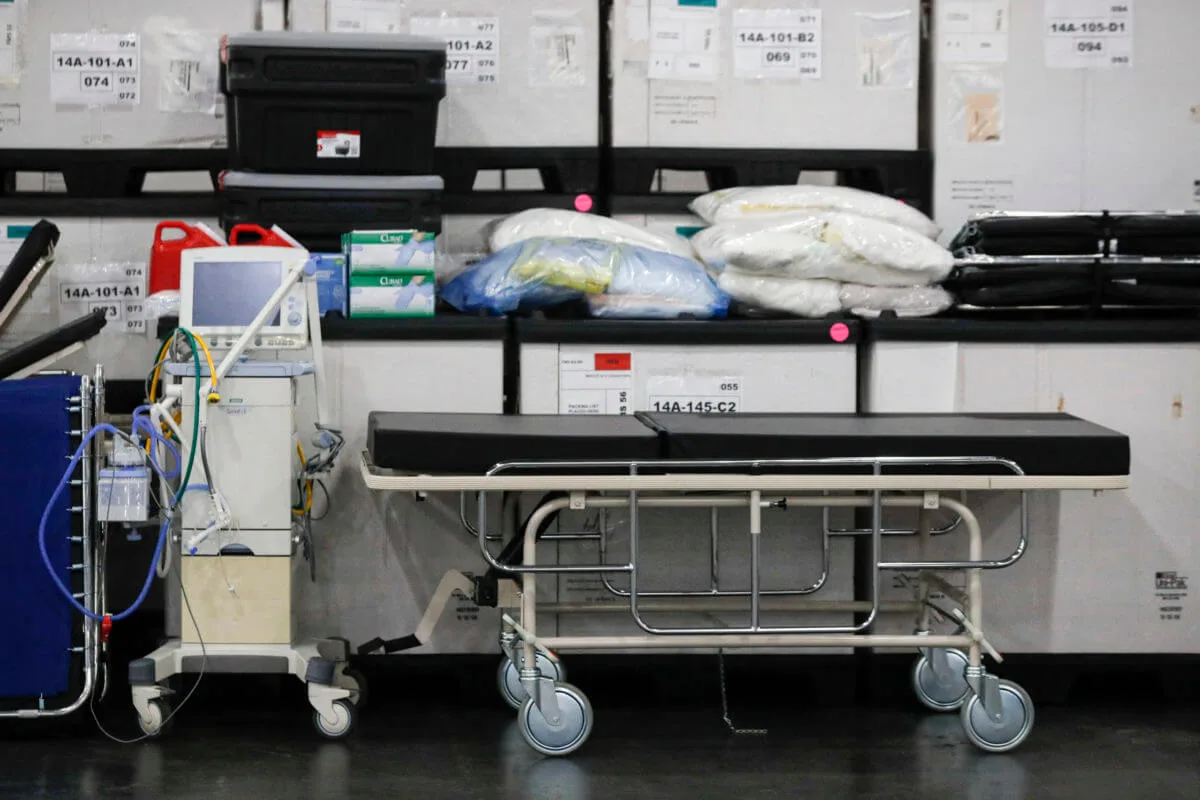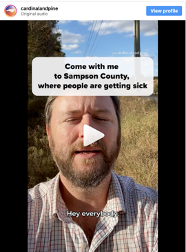
AP Photo/John Minchillo, File
Often thought to be an urban problem, the coronavirus has taken a grim toll in some of the state’s most remote parts.
North Carolina’s cities initially bore the brunt of coronavirus in the state.
But while Charlotte and Mecklenburg County are home to the most confirmed cases and the most COVID-19 deaths thus far, new hotspots are emerging in far more rural and remote parts of the state. And the virus’ spread into rural counties, and the deaths that followed, show why COVID-19 has been even deadlier there.
“When you look at deaths, rural counties seem to be bearing a higher burden from the disease,” David Tillman, chair of the public health department at Campbell University, told Cardinal & Pine.
That’s true in Harnett County, where Tillman lives and works. By April 28, seven residents had died from COVID-19, putting it ahead of more urban counties like Forsyth, home to Winston-Salem. The picture is even more grim for other rural counties.
As of April 30, Henderson County — south of Asheville — had reported 20 deaths from COVID-19. That’s more than Durham County — a much more dense and populous region where the death rate is fast rising.
“Rural counties seem to be bearing a higher burden from the disease.”
David Tillman, chair of the public health department at Campbell University.
It’s also more deaths than Wake County, North Carolina’s most populous county, evidence that COVID-19 is at its deadliest when it strikes more vulnerable populations. As of Friday, the state reported three coronavirus outbreaks in Henderson County nursing homes.
Indeed, new figures released by the NC Department of Health and Human Services (DHHS) show that of NC’s 378 confirmed coronavirus deaths, more than half were in congregate living centers like nursing homes, residential care centers and prisons.
Mecklenburg County, NC’s most urban county, still reports the most deaths — 47 as of Thursday — followed by densely populated Guilford County with 26. Yet Rowan County, a suburban county northeast of Charlotte, is close behind with 20 deaths. Franklin County, northeast of Raleigh, has reported 19.
More troubling still is the noticeably elevated per capita death rate in several of North Carolina’s more rural areas. Despite reporting the most coronavirus deaths overall, Mecklenburg County’s number of COVID-19 deaths per 100,000 residents is 3.87, slightly higher than Guilford County and slightly lower than Durham County. Wake County has only reported 1.35 deaths per 100,000 residents.
Yet the story is dramatically different in more rural counties.
In Franklin County, which has less than 70,000 inhabitants, the rate is about 25 deaths per 100,000 residents, almost 20 times worse than neighboring Wake.

Columbus County in southeast NC — one of the most rural counties in the state — reported 9 deaths by Thursday. With around 55,700 residents, that’s about 16 deaths per 100,000 residents.
Henderson and Rowan counties weren’t far behind, with more total deaths each than Columbus County but slightly lower rates at 13.6 and 13.4 respectively.
Mark Holmes, director of UNC’s NC Rural Health Research Program, said these bleak figures are mirroring a national trend.
“Initially, we saw COVID-19 primarily impact urban areas — both nationally and in North Carolina,” he said. “But as the epidemic has evolved, rural areas have been impacted as well.”

Tillman agreed.
“At first, COVID-19 — and really any virus like it — is going to affect places that are population-dense with a vengeance,” he said, citing New York City and the areas around Charlotte and Raleigh. “However, what you’re seeing now is that in the urban commuting zones, you’re seeing a pretty consistent spread, and now most counties in North Carolina have cases.”
While explaining that his analysis was only “rudimentary” because the landscape is rapidly evolving, Tillman said it looked like the case fatality rate is about double for rural counties in the state.
“In many rural communities, it’s just starting,” he said. “You can look at cases per capita and realize that rural places are catching up to urban counties. Data suggests this is a problem that’s going to be facing rural places in an increasing area of concern, and the outcomes look like they may be worse.”
Tillman said he expects the virus will worsen existing health disparities, negatively affecting communities that already experience worse health outcomes in the state including poor communities, communities of color, and rural communities.
As Cardinal & Pine reported in April, Black North Carolinians already make up a disproportionate number of COVID-19 cases and deaths in the state, following a national pattern.
There are a variety of factors that differentiate North Carolinians who live in rural and urban areas.
More than 1 million people lack health insurance in the state, and many of them are in far-flung mountain and coastal communities. More than half a dozen rural hospitals have closed here in the last 15 years, most recently in Mocksville, Hamlet, and Scotland Neck. And before the virus hit, at least four more were considered to be at “high risk of financial distress.”
While the rural mortality rate has fallen in the last 20 years, it hasn’t fallen as sharply as the urban mortality rate has, meaning the mortality gap grew from 6% to 18%, according to research from Holmes and the NC Rural Health Research Program earlier this year.
“Generally, rural areas have more vulnerable populations — more intergenerational households, older populations, higher rate of comorbidities,” Holmes told Cardinal & Pine. “In addition, rural healthcare is often more fragile — fewer beds per capita, providers with tighter finances. I think in particular, staffing in rural providers may be in shorter supply — older age, for example, and one infected professional may be a huge problem.”
In other words, he said, if you imagine the sole respiratory therapist in a hospital gets infected with the COVID-19, it’s a much bigger problem than it would be in a hospital system with several.
If rural areas skew older as Holmes said, that could also bode poorly for the virus death rate in those communities. As of April 28, only 4% of North Carolinians who died from COVID-19 were under 50 years old. A staggering 87% of the deceased were 65 or older.
Tillman said there is a wide range of existing health disparities for rural communities that could affect the outbreak,including geographic isolation, transportation hurdles, under-resourced hospitals, and more. But rural areas face other challenges too, he said.
“The danger is that if we misunderstand how the timelines are slightly different for urban and rural places — and rural (counties) are lagging behind by a couple weeks — then there’s a fear that there might be an attention fatigue, compassion fatigue, vigilance fatigue,” he said.
In other words, rural counties that haven’t been hit hard yet may feel pressure to reopen prematurely, or once new cases drop in cities, restrictions could be eased just as the situation worsens in rural areas, Tillman said.
“When the governor makes the decision to shut down the state,for all the right reasons,that’s before it’s affecting some counties,” he explained. “But if you’re shut down and have very few cases in your county… local policymakers may want relief from these policies.”
Protests demanding Gov. Roy Cooper lift the state’s stay-at-home order have already arrived, with similar demonstrations in Michigan and Tennessee.
Despite skyrocketing cases and rising deaths, some nearby states such as Georgia and South Carolina have moved to reopen. Meanwhile, neighboring Virginia’s lockdown will continue until at least June 10. Cooper recently extended the state’s stay-at-home order to May 8, though it’s unclear if he will renew it for even longer. The answer may depend, in part, on just how hard the virus batters the state’s rural counties.

Op-Ed: Studying the Holocaust remains vital to ensuring it never happens again
International Holocaust Day will be observed on January 27, 2024. This day commemorates the liberation of the Auschwitz concentration camp by the...

VIDEO: How Rural Broadband Is Coming to This North Carolina County
More than 1.1 million North Carolinians lack access to high-speed internet, a necessity of the modern economy. In Warren County, help is on the way,...

VIDEO: Sampson County puts Biden’s promise to boost rural infrastructure to the test
Locals in this rural NC county say their water and air is polluted by a PFAS-contaminated landfill, massive hog and poultry farms, and industrial...

VIDEO: Sampson County puts Biden’s promise to boost rural infrastructure to the test
Locals in this rural NC county say their water and air is polluted by a PFAS-contaminated landfill, massive hog and poultry farms, and industrial...

Mold and classes in trailers: Inadequate funding for schools is hurting NC communities
Schools across the state are dealing with dilapidated classrooms and buildings in need of significant repair or a total rebuild due to a lack of...







